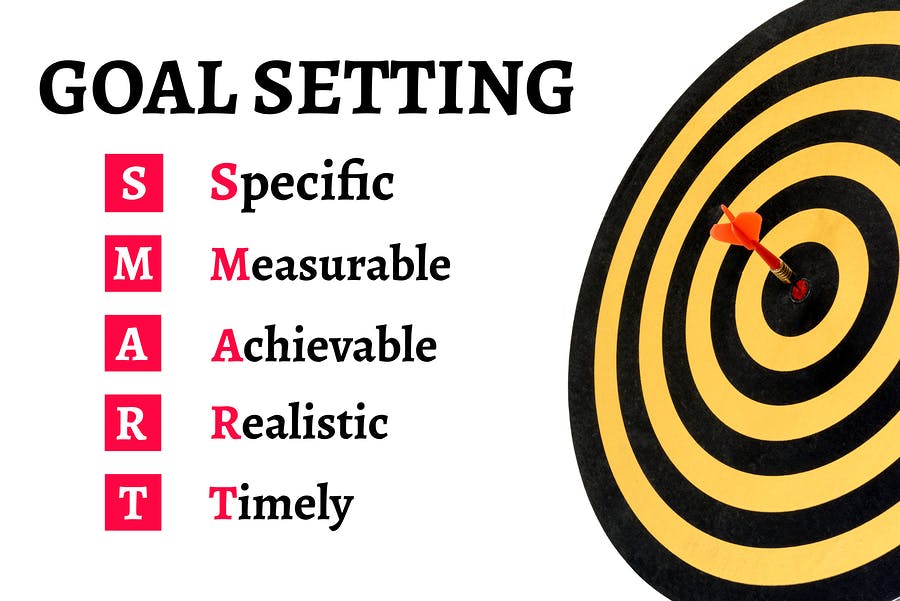Goal setting is an undeniably important step on the road to achievement, be it personal, or in the workplace. Goals serve four basic functions: providing guidance and direction, facilitating planning, motivating and inspiring employees, and helping evaluate and control performance. As a manager, it’s vital to set goals for your team or make sure they have their own goals to strive towards. This is not only to ensure they’re working towards company success but also that they are motivated and committed in terms of the tasks they’re completing.
It can, however, be questionable how useful and well thought-out some goals are. If you set goals that are unrealistically high, they can be demotivating, leading to failure. They become equally problematic when they’re aimed too low so people feel they have nothing to strive for.
Having useful, productive goals in place can make all the difference when creating a team which works both as individuals and together toward clear, established aims. Those without clearly outlined goals can encounter problems. That’s where you, as their manager, can step in and help your employees set attainable, yet challenging goals.
Setting achievable goals
With SMART goals, you can be sure that you’re setting attainable and achievable benchmarks that can lead to your development and success, or that of those around you. SMART goals are those that are: Specific, Measurable, Assignable, Relevant, and Timely. Outside of that, the goals can be made to suit your own needs and expectations.
The following are examples of some SMART goals you can set in the workplace, outlining how they meet SMART goal criteria.
Specific
There’s no point setting vague goals that don’t achieve anything specific. Edwin Locke and Gary Latham, pioneers in the field of goal-setting, found, “that specific, difficult goals consistently led to higher performance than urging people to do their best.” They also noted, “the highest or most difficult goals produced the highest levels of effort and performance.” It’s important for both you and your employees to have clear and established aims, to avoid potentially setting goals so broad that they are overwhelming and therefore too difficult to set into action.
Measurable
Once you have a specific goal pinned down, it’s important to be able to measure the success or completion of the goal. This doesn’t have to be in the traditional sense, like on a numeric scale or a statistic, it just has to be measurable in some sense, so that it is clear when you have reached or are close to reaching your goal. This is a great way to keep track of progress in the workplace, for both you as a manager and your team members: if the goal is to expand the number of followers on Twitter, for example, having a measurable goal in the form of a number is a sure-fire way of measuring and tracking progress.
Assignable
A SMART goal must be assignable to someone, be it yourself, your team, or individual team members. If you decide you want to achieve something as a team it is important that someone is responsible for tracking progress, implementing action steps, and keeping the team motivated.
Relevant
It is essential that any goals set for teams or individuals are relevant to them and align with company needs. Of course, goal-completion is important and having goals met or worked towards is the overall idea when setting them, but this is only really beneficial when the goals are productive in the workplace and will contribute to company success in some way.
As a manager, it is particularly important that you help your employees link their individual goals back to the wider team and company-wide goals. One of the best ways to motivate your employees is to make sure they know how their work is contributing to the bigger picture.
Timely
Goals must be time-related. It’s not productive to set a deadline too far in the future for a simple task, or an unrealistically short deadline for something complex and time-consuming. This common pitfall can be demotivating, either leading to early completion and a lack of urgency in task completion or creating enormous stress and potentially incomplete or inadequate performance because of lack of adequate time.
Here is an example of a SMART goal:
- Specific — Have each employee cross-trained on at least one other job on their team by the end of the second quarter:
- Measurable – Review progress with each team member bi-weekly. Assess skill development using standardized testing materials at the end of each month.
- Accountable – Each team manager to report on progress monthly.
- Relevant — Improves production efficiency and increases project continuity in the event of a loss of team members. Is part of the overall success management plan.
- Timely — Milestones are monthly with completion of training and proof of proficiency by end of Q2.
Some companies replace “Relevant” with “Realistic” in their SMART criteria to emphasize this point. Although we place emphasis on relevance in our outline, the importance of setting realistic goals, taking into consideration your team members and their capabilities and resources, should not be underestimated. Having clear, concise and relevant goals makes any work environment more communicative, motivating and effective.
